Gum Disease Treatment Coral Springs
Targeted & Comfortable Gum Care
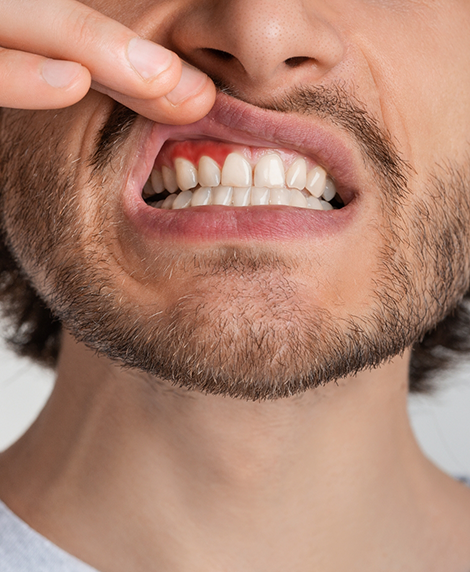
It’s estimated that gum disease affects 75 percent of Americans over the age of 35. If you’re shocked by that statistic, we believe you should be. Gum disease, or periodontitis, can have severe effects on otherwise healthy bodies, contributing to increased risks of tooth loss and serious heart problems, like cardiovascular disease, heart attacks, and high blood pressure. There is encouraging news in the fact that gum disease is incredibly easy to prevent -- and if it’s caught in its earliest stages, it’s also reversible. Learn more about this condition - and our options for gum disease treatment in Coral Springs - to enjoy better gum health throughout your lifetime.
Why Choose Iglesias Dental Group for Periodontal (Gum) Disease Treatment?
- Advanced Periodontal Treatment Available
- In-House Board-Certified Periodontist (Gum Specialist)
- Serving Coral Springs Since 1988
Gum Grafting
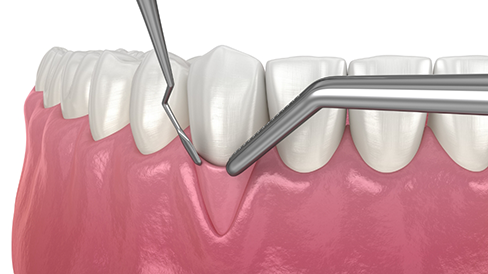
Gum grafting is commonly used to correct gum recession, and if left untreated, will cause recession to the point of root exposure, tissue inflammation, and in severe cases, tooth and bone loss. Gum grafting is used to treat and reverse gum recession. Because we have an in-house periodontal specialist, our team is able to provide a multitude of grafting procedures on-site, helping patients restore both the aesthetics and health of their smiles without a referral.
Types of Gum Grafting
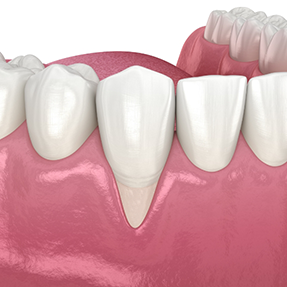
There are three types of gum grafting surgery to treat gum recession:
- Connective Tissue Grafts: Tissue for the gum grafting is taken from underneath a flap of skin cut into the roof of your mouth. Once the flap is sutured, the new gum tissue is attached to the site of the gum recession which will integrate with the tissue that is already present.
- Free Gingival Grafts: This type of gum grafting surgery is similar to connective tissue gum grafting. The distinction between the two is that the tissue for the graft is taken directly from the roof of the mouth instead of creating a flap.
- Pedicle Grafts: This method of gum grafting uses the tissue surrounding the site of the gum recession instead of taking it from the roof of the mouth. In this procedure, a flap, or pedicle as it is called, is cut into the gum leaving an edge attached. The flap is then stretched over the site of the gum recession and sutured in place. This type of gum grafting is generally used for patients who have healthy amounts of tissue surrounding the gum recession site.
What Can I Expect After Gum Grafting?
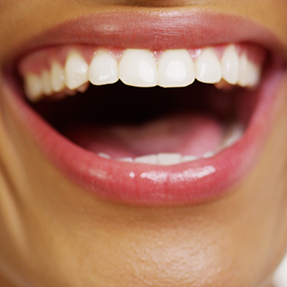
You should avoid flossing or brushing near the newly placed tissue until it has had time to heal. Dietary restrictions will be in place for up to a week post-procedure, limiting your intake to soft foods. Most patients find they fare well with an over-the-counter anti-inflammatory medication. Patients undergoing gum grafting for gum recession can expect to return to work within a day or two following the gum grafting procedure.
Esthetic Crown Lengthening
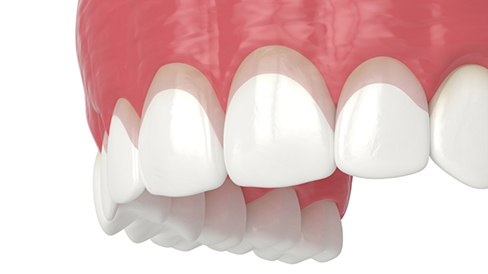
Those who feel that they have a “gummy” smile can greatly benefit from esthetic crown lengthening. This relatively simple procedure usually takes about an hour to perform and is essentially a gum lift. During the procedure, the doctor removes excess gum and bone tissue and reshapes the smile to expose more of the natural tooth. While the procedure can be performed on just one tooth, it is most often done to the entire smile. The result is that more of the natural tooth is exposed creating a wider, more beautiful smile.
Esthetic crown lengthening can also be done to preserve the health of the smile. Removing excess gum tissue can help control and prevent periodontal disease. Increasing the exposed surface area of the tooth will decrease the depth of pockets between teeth where bacteria can grow and harm your teeth and gums.
Prior to the procedure a local anesthetic will be administered to prevent pain and discomfort. Small incisions in the gum tissue will be needed to separate the gums from the teeth. In some cases, a small amount of bone will also need to be removed to create a natural smile. Once the procedure is completed, the doctor will clean the incisions with sterile water and place sutures and a protective bandage over the area to encourage the teeth and newly contoured gums to re-attach to each other. A follow up appointment will be needed one to two weeks after the procedure to evaluate healing.
Periodontal Plastic Surgery refers to cosmetic procedures performed on the gums to enhance the appearance and health of the smile.
Functional Crown Lengthening
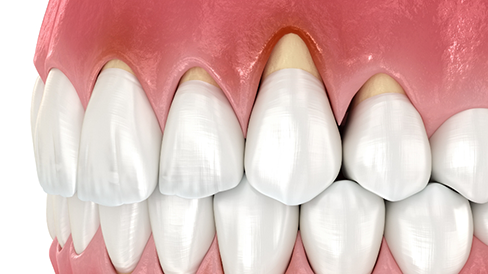
Sometimes functional crown lengthening will be needed to perform a cosmetic or restorative procedure. This may be the case if a tooth is too far decayed, broken below the gumline, or has insufficient structure for restoration like a crown or bridge. In cases like this, the dentist may be required to lower the gum and bone levels to expose more of the root surface so it can be restored. However, simply trimming back the gum line is not sufficient. Instead, the doctor will need to reshape the gums and supporting bone to allow for adequate room to place a high-quality restoration.
The procedure is similar to esthetic crown lengthening in that a local anesthetic will be administered. Small incisions are required to remove the gum tissue and reshape the area. When the procedure has been completed, the dentist will place sutures that will need to be removed in one to two weeks. After the area has completely healed (6-8 weeks), the final restorative dentistry such as a crown or bridge can be placed.
Bone Graft
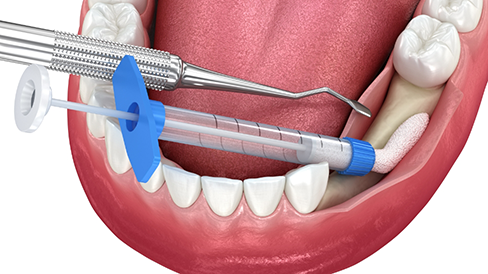
After a tooth has been lost, the jawbone in the area naturally starts to atrophy and weaken. This can erode the foundation of nearby teeth and make it more difficult to fill the space with a dental implant. With a bone graft, we can place donated tissue onto the area to stimulate the growth of new, healthy bone, creating the ideal environment for an implant to succeed while protecting a patient from future tooth loss.
Alveoloplasty

Frenectomy
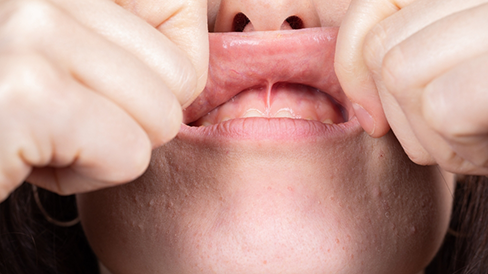
Lip and tongue tie are problems that stem from these parts of the mouth not being able to move properly due to an overly short or thick frenulum. This is a small band of tissue, and people actually have three—one beneath the tongue and one on each lip that connect it to the gums. These issues can make breastfeeding almost impossible for children and lead to dental and speech difficulties in teens and adults. With a quick laser treatment, however, we can fully restore someone’s oral function and health by loosening the frenulum.
Gingivectomy
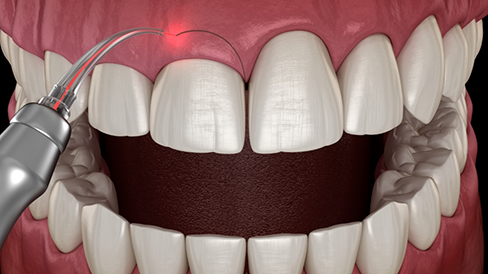
Every dental emergency is different, which means that the cost of treatment varies drastically from patient to patient depending on the care they need. At Iglesias Dental Group, we believe that no patient should have to throw their monthly budget out the window because of something out of their control like a dental emergency. That’s why we guarantee that we have an expert dentist that accepts your insurance. We also offer additional financing options like CareCredit to work with your budget. For any additional information, don’t hesitate to contact us! One of our dental professionals will be more than happy to answer any questions you may have.
The Procedure
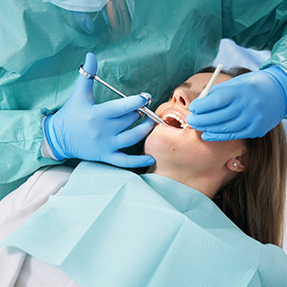
Before the procedure begins, the area will be completely numbed using a local anesthetic. Small incisions are made and excess gum tissue is carefully removed. After all areas of diseased tissue are removed, a putty-like substance is sometimes placed over the gums. This substance is designed to protect your gums as they heal.
After the Procedure
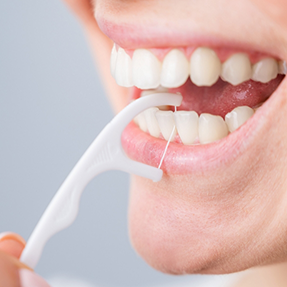
After the procedure, it is important to eat only soft foods and to drink only cool or slightly warm liquids while the putty is in place and your gums are healing. It is important to keep the mouth clean after the procedure. While it is important not to brush in the area where the procedure was performed, it may be possible to brush and floss the rest of the mouth. After a few weeks the gums will be completely healed and Dr. Gutt will advise as to when it will be possible to resume brushing and flossing, though this should be done gently at first.
Ridge Augmentation
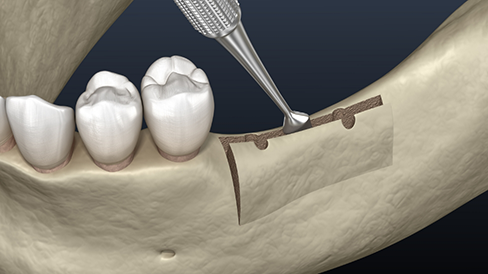
Ridge augmentation is a common procedure performed to help recreate the natural contour of the gums. Often, after a tooth is removed, the bone in the jaw will begin to deteriorate and recede. The height and width of the socket, which was supported by the tooth, will begin to shrink after the tooth is removed. Many patients will eventually develop an indentation in the gums or jawbone where the tooth used to be.
Restoring the original height and width of the socket is not usually medically necessary. However, it may be necessary in order to place a dental implant or for aesthetic purposes. If a person’s bone has deteriorated too much, placing a dental implant may not be possible.
The Procedure
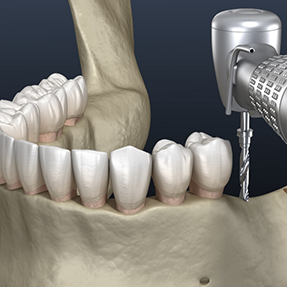
There are two types of Ridge Augmentation procedures: Soft Tissue and Hard Tissue. Occasionally, both types of ridge augmentation are performed at once.
Soft tissue grafts are usually done to improve the esthetics and cleanability of the site. Prior to the procedure, the area will be numbed. An incision is made to expose the site and a soft tissue graft is then obtained either from the palate (roof of the mouth) or a soft tissue substitute. The graft is then inserted into the area receiving the graft, which is then secured with stitches.
Hard tissue grafts are done to recreate adequate bone contouring prior to dental implant placement. Prior to the procedure, the area will be numbed. An incision is made and the gum lifted away to expose the bone defect. A bone graft obtained either from another site within the mouth or cadaver bone is placed in the area receiving the graft and secured using titanium screws. The area is then closed with stitches.
Healing time varies by patient and the size of the area repaired but usually lasts no longer than 6 months.
Scaling & Root Planing
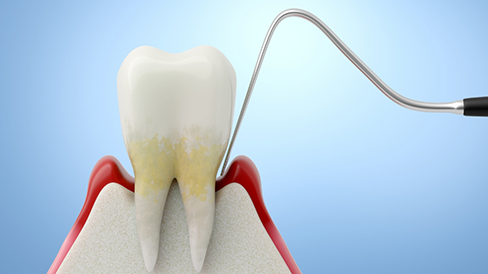
Scaling and root planing is a deep cleaning below the gumline used to treat gum disease. Gum disease is caused by a sticky film of bacteria called plaque. Plaque is always forming on your teeth, but if they aren’t cleaned well, the bacteria in plaque can cause your gums to become inflamed. When this happens, your gums will pull away from your teeth and form spaces called pockets. Plaque then gets trapped in these pockets and cannot be removed with regular brushing. If untreated, gum disease could lead to bone and tooth loss. If gum disease is caught early and hasn’t damaged the structures below the gum line, a professional cleaning should do. If the pockets between your gums and teeth are too deep, however, scaling and root planing may be needed.
What Happens During Scaling and Root Planing?
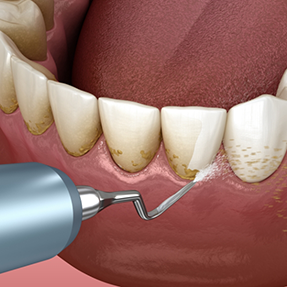
This deep cleaning has two parts. Scaling is when your dentist removes all the plaque and tartar (hardened plaque) above and below the gumline, making sure to clean all the way down to the bottom of the pocket. Your dentist will then begin root planing, smoothing out your teeth roots to help your gums reattach to your teeth. Scaling and root planing may take more than one visit to complete and may require a local anesthetic.
Aftercare Tips

After a deep cleaning, you may have pain for a day or two and teeth sensitivity for up to a week. Your gums also may be swollen, feel tender and bleed. To prevent infection, control pain or help you heal, your dentist may prescribe a pill or mouth rinse. Your dentist may also insert medication (subantimicrobial-dose doxycycline) directly into the pocket that was cleaned.
Your dentist will schedule another visit to see how your gums have healed and measure the depth of your pockets. If they have gotten deeper, more treatment may be needed. Good dental care at home is essential to help keep gum disease from becoming more serious or recurring.
Antibiotic Therapy
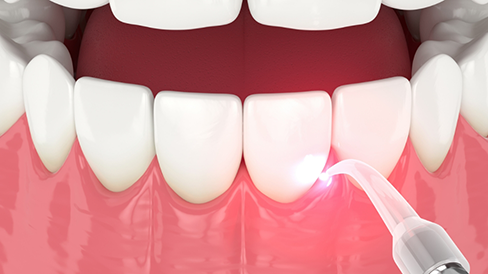
Because gum disease bacteria are so good at hiding deep within periodontal pockets, it sometimes can’t be fully removed through scaling and root planing. Antibiotic therapy involves placing the medication directly onto the gums so it’s able to reach and kill the bacteria to prevent reinfection.
Osseous Surgery
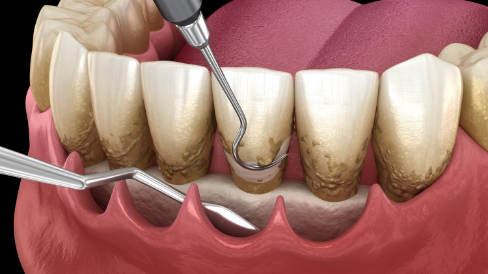
Osseous surgery, or flap surgery, is usually performed when a pocket around a tooth (or teeth) has not responded to other treatments. The procedure is performed to create a clean environment around the tooth so that the tooth can be retained rather than lost. Osseous surgery is generally tried only after other treatments have been explored and tried and usually is performed when the pocket depth has worsened over time.
The Procedure
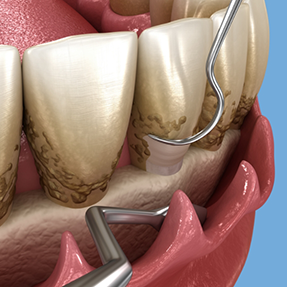
Before beginning the procedure, the area will be numbed using a local anesthesia. An incision is made in the gum tissue around the area that will be treated. The gum is then lifted away from the tooth and the underlying bone so that there is direct access to the area. The surface of the tooth is then thoroughly cleaned of any plaque buildup.
Next the surface of the bone will be smoothed. Bacteria trapped in the pocket around the tooth will eat away at bone making it uneven and rough. In order to ensure proper healing, smoothing the bone of these rough surfaces is necessary.
After the root of tooth has been cleaned and the bone smoothed, the gum tissue is then trimmed to match the new underlying structure and stitched into place. The stitches are placed to hold the gum tissue in the correct position as it heals.
After the Procedure

After the procedure you may be prescribed a pain medication. Stitches will be removed in 6-10 days unless dissolving stitches are used. About a month after surgery, an appointment should be scheduled to check on the healing of the area. Because some gum tissue is trimmed during the procedure, the tooth may appear longer in the mouth. This may cause increased sensitivity to hot or cold.
Periodontal Maintenance
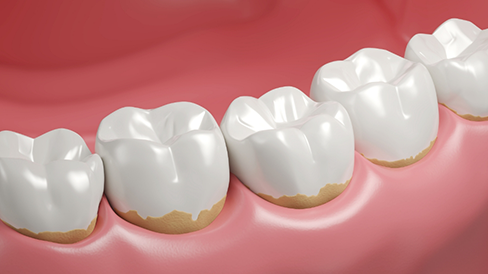
Periodontal maintenance therapy is an ongoing program designed to prevent periodontal disease in in the gum tissue and bone. Periodontal maintenance is usually necessary for patients who are susceptible to periodontal disease or who have been treated for gum disease. Maintenance visits will help prevent additional dental problems in the future. Treating the disease in its early stages saves you not only discomfort but also money!
Why Is Periodontal Maintenance Necessary?
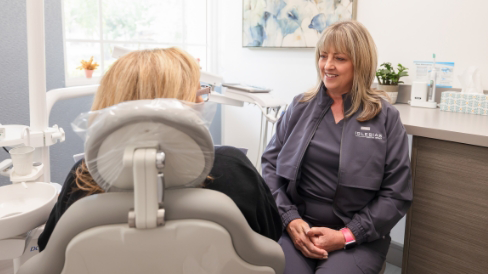
Gum disease is caused by the bacteria found in plaque. The toxins produced by the bacteria attack your gums and teeth. And, if the plaque is not removed, it will harden and form calculus. Even someone dedicated to good oral hygiene will be unable to completely prevent the formation of calculus on the teeth. Flossing and brushing will keep the calculus to a minimum but regular maintenance is needed to professionally remove what has been missed. During your maintenance cleaning, the hygienist will also check for hidden periodontal problems.
How Often Do I Need a Periodontal Maintenance Visit?
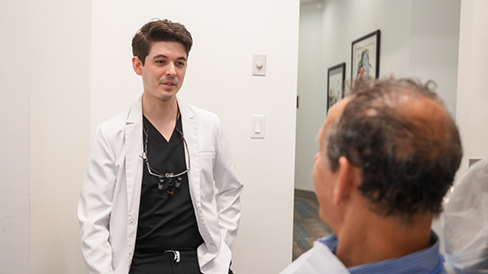
The doctor will recommend how often you should have a periodontal maintenance visit. The frequency will be determined by the type of periodontal disease you have, the type of periodontal treatment you have had in the past, how you’ve responded to those treatments, and how quickly you develop plaque. The most important factor, however, is how dedicated you are to good hygiene at home.
I Need a Checkup & Cleaning I Need a Dentist for My Child I Have a Cavity or Broken Tooth I am Missing One or More Teeth I Want to Enhance My Smile I Have a Dental Emergency I Need Oral Surgery I Have Jaw Pain/Headaches I Am Afraid of the Dentist I Snore/Have Sleep Apnea View Our Services
